Scalp Micropigmentation: The Ultimate Guide
Read our comprehensive guide for all you need to know about scalp micropigmentation – does it work, how it’s done, who it’s for, how much it costs, and more.
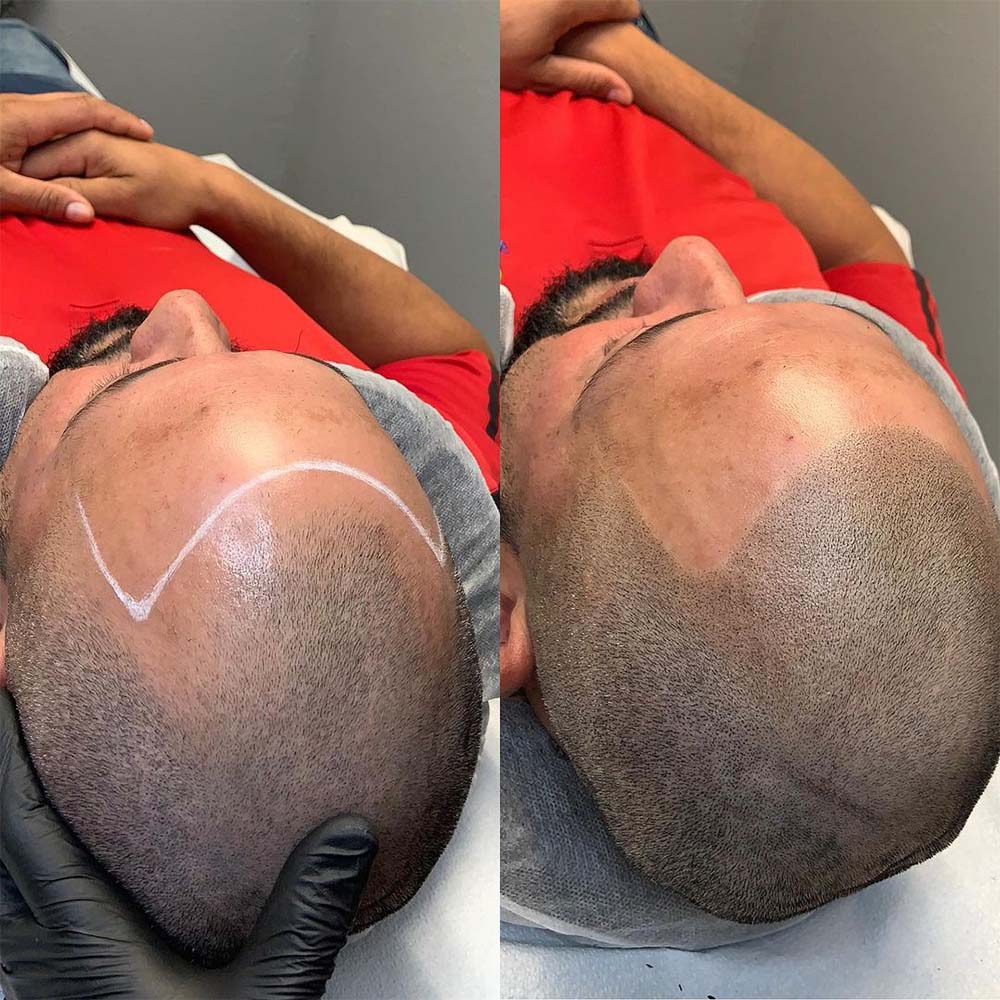
Image source : PMUhub
Explore more scalp micropigmentation topics
Updated in February 2023.
Scalp micropigmentation is the only hair-restoring solution that gives immediate and guaranteed results. It’s a long-term, relatively cost effective way to camouflage bald patches and scars, re-densify bald spots, bring down the receding hairline, or just add volume.
Read this guide to find out everything you need to know about scalp micropigmentation, or SMP for short.
ABOUT SCALP MICROPIGMENTATION
What Is Scalp Micropigmentation?
Scalp micropigmentation is a form of cosmetic, or paramedical tattooing, meaning it’s done in a similar way to a tattoo, but there are some crucial differences. It creates an illusion of more density by covering the scalp with dots that look like hair follicles, i.e. hair which is starting to emerge.
The look is created using a machine designed specifically for cosmetic micropigmentation to implement pigments shallow into the skin of the scalp. It’s important to understand that scalp pigmentation is not a traditional tattoo – the colors used are formulated differently from tattoo ink so that they can be broken down by the body, and they’re implanted a bit closer to the surface of the skin.
So scalp micro pigmentation does not last forever, although it can last out for 8 years or longer.
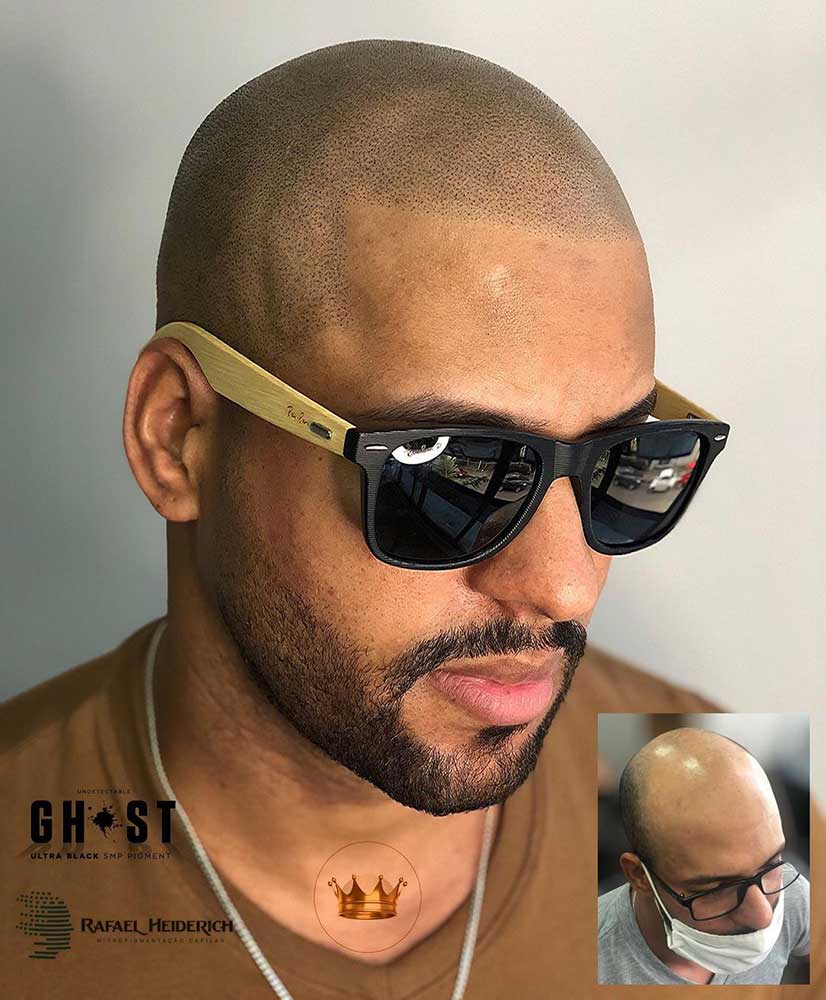
Who Is a Candidate for Scalp Micropigmentation?
Anyone who needs hair restoration, whether it’s on the whole scalp, in patches, over scars, or they need extra density between existing hair which might be thinner than you want it. That said, there are certain contraindications.
What Is Scalp Micropigmentation?
Certain conditions make cosmetic tattooing unsafe. If you suffer from any of the conditions listed, you cannot undergo the treatment, or you need a doctor’s clearance:
- People with diabetes (consult your doctor)
- People with bleeding disorders
- People who take blood-thinning medications (consult your doctor and discontinue use if possible)
- Pregnant or nursing women
- People with a history of keloids or hypertrophic scarring
- People with viral infections or diseases
- People who are going through chemotherapy
- People with skin irritations or Psoriasis near the scalp area
- People whose skin was tanned recently
Can Both Men and Women Get Scalp Micropigmentation?
Of course!
The technique can solve a number of hair issues. With scalp micropigmentation hair can be recreated in the form of skin follicles, so the results look like a freshly shaved head, but if placed between longer hair, they just look like a shade which gives the illusion of hair thickness.
While men most often deal with male pattern baldness and a receding hairline, thin hair and bald spots can occur in both men and women. It works on areas with no hair, but can also improve the look of patches where hair is sparse.
If a larger bald area is treated, the look is a buzz cut style – the area looks like the hair was shaved off and the hairs are just starting to grow back out. This is perfect for clients who have no or very little and cut it very short anyway.
But it can also densify sparse, longer hair. The areas between the natural strands are shaded with the dotting technique, and the result is an illusion of more density. This works very well on women, regardless of the length of the hair. Of course, the hair will still be thin, but the scalp won’t be so prominently visible through it.
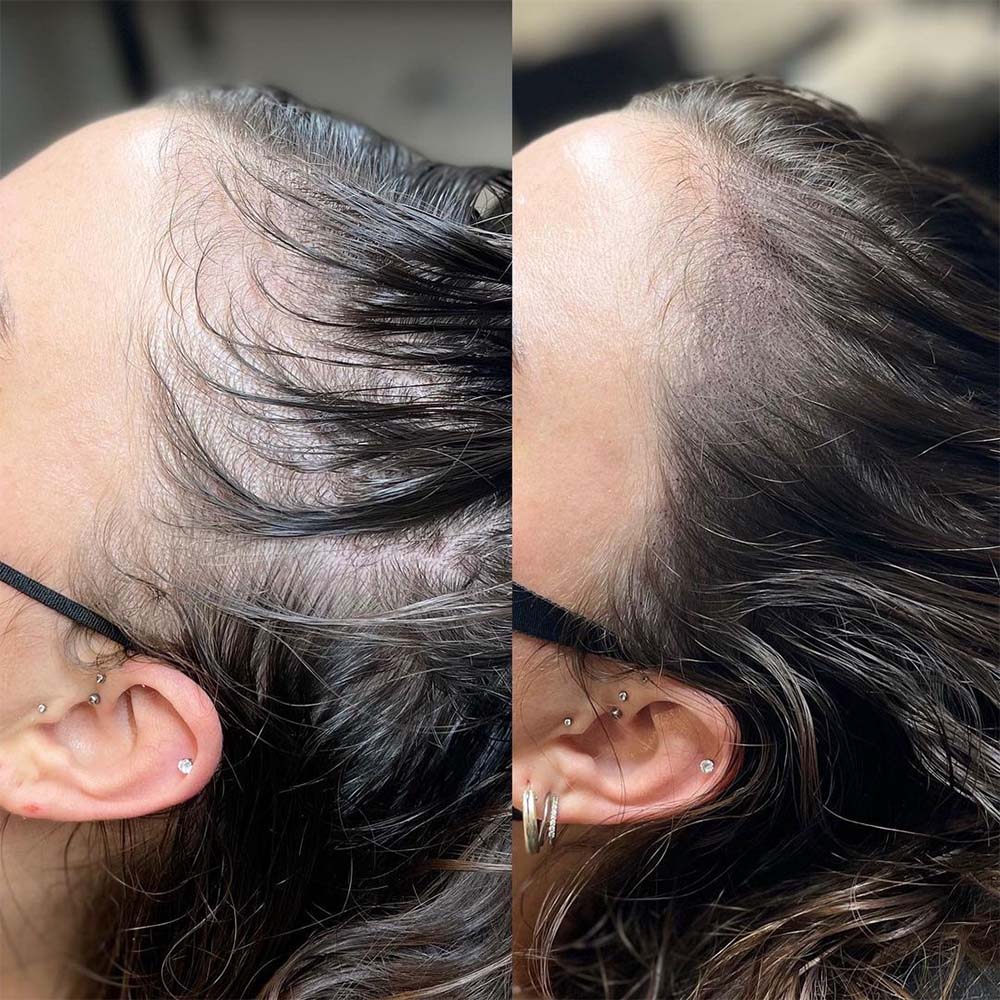
SCALP MICROPIGMENTATION EFFECTS
What Issues Can Scalp Micropigmentation Solve?
SMP can treat the whole scalp area, or only patches. Here’s a list of issues scalp pigmentation can help camouflage:
- Total baldness
- Male pattern baldness
- Receding hairline
- Bald patches
- Scars on the scalp
- Sparse hair
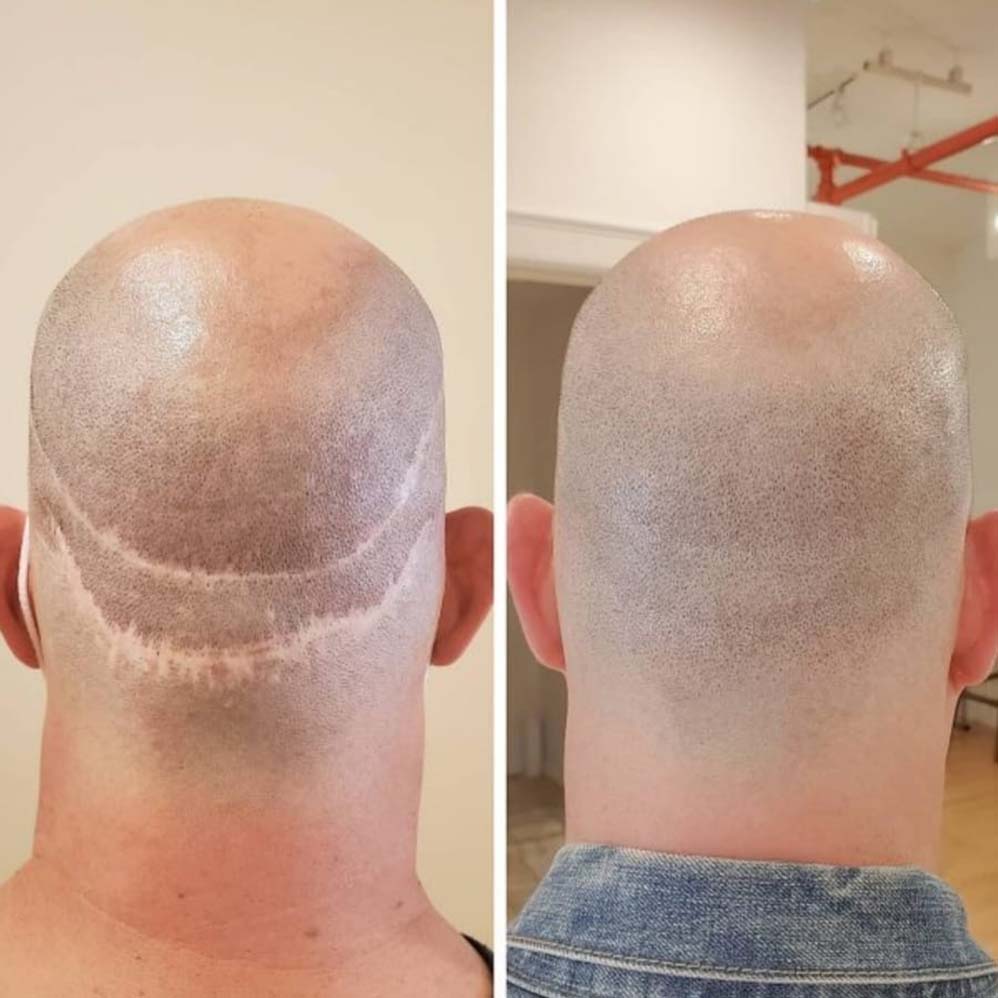
How Long Does Scalp Micropigmentation Last?
The longevity of the results is very individual and it depends on many factors. Generally, scalp micropigmentation lasts between 4 and 8 years for most clients, but there are cases of it fading after just a year or two, or lasting out as long as 10 years.
As a form of cosmetic pigmentation, SMP fades gradually. The pigment inks used are formulated in such a way that the immune system breaks them down and extracts them from the skin, fading them. This happens gradually, over a period of several years, but the results can be refreshed if you want to keep them longer.
Are There Any Scalp Micropigmentation Disadvantages?
The biggest disadvantage is the fact that scalp micropigmentation is the fact that it can’t recreate physical hair follicles, just give the illusion of a buzzcut.
There’s also the fact that it needs refreshing from time to time, and the minor risk of complications.
SCALP MICROPIGMENTATION TREATMENT
How Is Scalp Micropigmentation Done?
Scalp micro pigmentation is the process of injecting pigment into the skin of the scalp in tiny dots, following a pattern best suited to camouflaging the issue in question. This is done with a machine that features a fine needle, so thin it imitates the diameter of a hair follicle.
The treatment is a process, and it takes several sessions to achieve the desired effects. Most clients need 2-3 sessions, but more might be necessary. It all depends on how well the skin retains pigments.
Here’s a step-by-step overview of the SMP treatment.
Consults
Book a consultation session with the scalp micropigmentation artist of your choice. They will inspect the area and tell you what results you can expect. They’ll also inform you of the treatment schedule and instruct you what aftercare routine to follow after the treatment.
You will decide on the shape of the hairline, but the color choice should be left to the artist to choose.
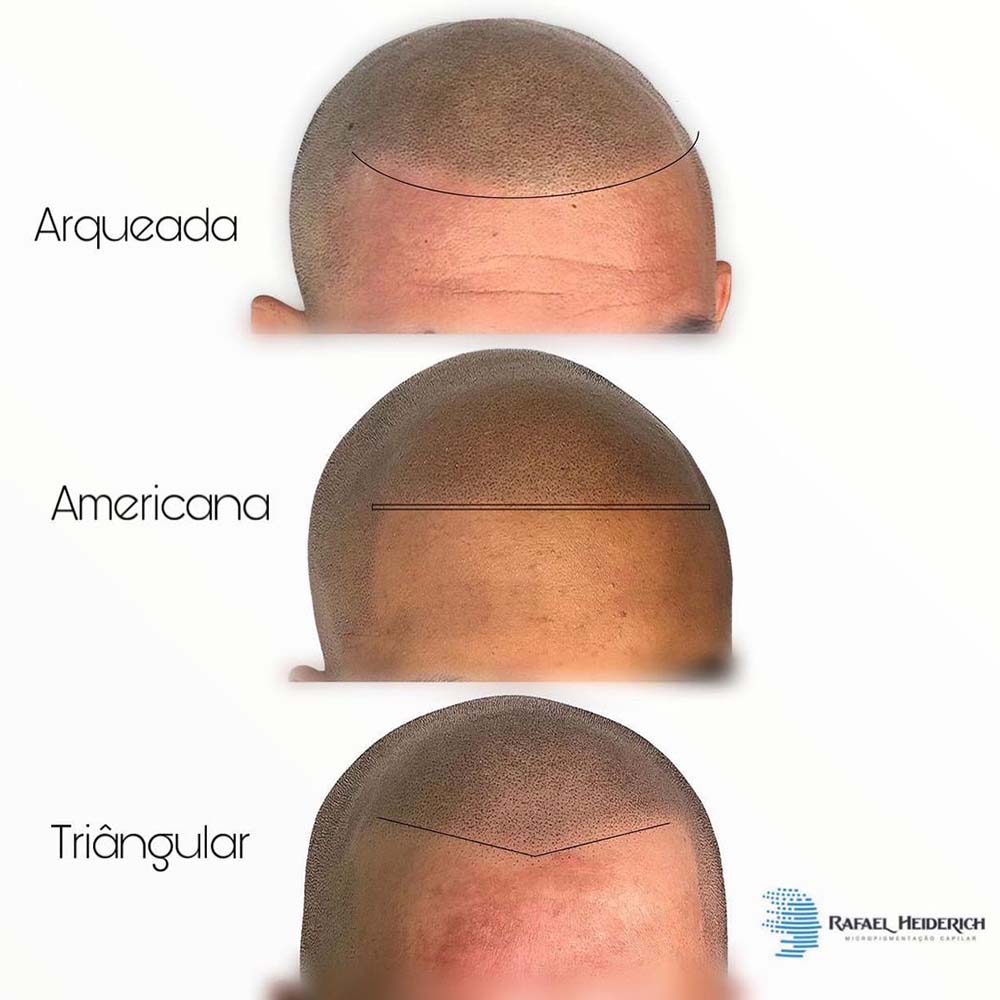
1st Micropigmentation Session
The first treatment creates the look to a large degree – the following sessions are top ups.
The session begins by drawing the outline of your future hairline. Once you’re happy with it, most artists apply a numbing cream that will eliminate the pain of the needling. It takes 15-20 minutes for the numbing to kick in, and when it does, the needling starts. The artist will go back and forth over the scalp with a pigmentation machine, saturating the skin with tiny dots of pigment.
The first session can take anywhere from 2 to 4 hours.
2nd Session
Your 2nd session is booked about 10-14 days after the first session. During that time, your results will first look very dark, then lighten as some of the pigment is extracted from the skin. Proper saturation can’t be achieved in 1 session, because the skin can’t retain a sufficient amount of pigment in 1 go.
During the second session, the artist goes over the dots again, replenishing them with pigment. It’s also an opportunity to modify the shape of the hairline if you want to.
This session won’t last as long as the first one.
3rd Session
After another 10-14 days, most clients need to come back in for another round of scalp micropigmentation (but not all – those with great retention may not need another session).
By this session, a significant amount of pigment should be retained and you can get a good sense of what the final result will look like. The 3rd session is an opportunity to replenish the pigments a bit further.
How Long Does the Treatment Last?
The first session of micropigmentation lasts between 2 and 4 hours, depending on the size of the area treated. The 2nd session should last about the half of the first, and any additional sessions will last even shorter than that.
Does Scalp Micropigmentation Hurt?
The treatment shouldn’t be exactly painful, but it might be uncomfortable. Most artists will apply a topical anesthetic to the area before they start working, which will eliminate the pain.
However, you will still feel certain sensations like pressure, tingling, or slight stinging. Nothing unbearable, but you should know what to expect.
Some areas of the scalp are more sensitive than others, so discomfort may be severe on the temples or the crown, the patch at the very top of the head. Scar tissue can also be more sensitive.
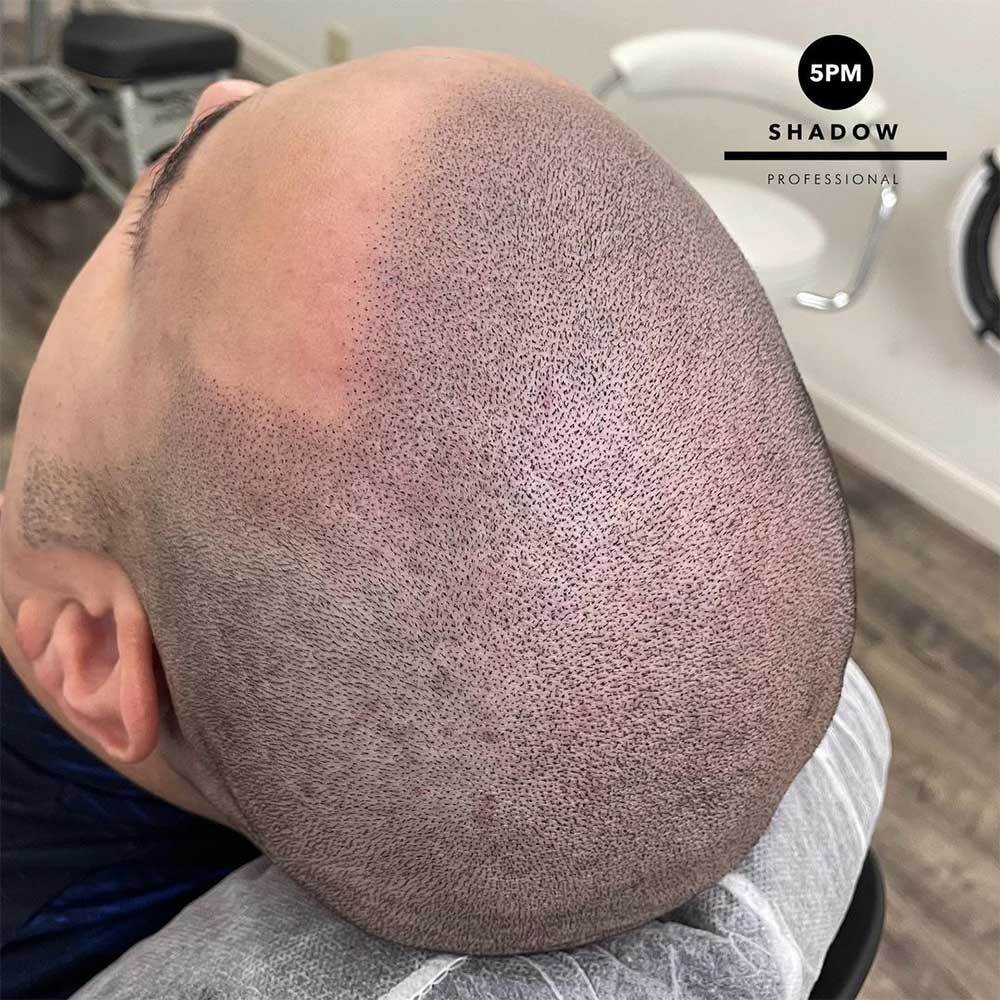
Is Scalp Micropigmentation Safe?
Yes, if done right.
Potential risks are infection or allergic reactions to the pigments or other products used.
Infections can occur if the treatment was performed in unsterile conditions or using unsterilized products, or in the case of improper aftercare and contamination in the days after the procedure. To prevent this, always go to a certified, licensed artist, and follow the aftercare instructions they give you as closely as possible.
To prevent allergic reactions, have the artist do a patch test before the treatment.
Does Scalp Micropigmentation Affect Hair Growth?
No. The layer of the skin treated is above the hair follicles, so you don’t have to worry about the treatment affecting hair growth.
PREPARATION FOR SCALP MICROPIGMENTATION
How Do I Prepare for Scalp Micropigmentation?
Here’s what to avoid before the treatment in order to for it to go smoothly:
- No sunbathing or tanning for about 2 weeks. Tanned skin is more sensitive.
- Stop using any retinol or Vitamin A products on the forehead and temples one month prior. These thin out the skin and make it bleed more.
- Avoid alcohol, caffeine, ibuprofen, aspirin, and fish oil supplements for at least 24 hours before your appointment.
- Don’t do any scalp treatments at least two weeks before the treatment.
- If you take blood-thinning medication, consult your doctor and see if it would be safe to discontinue the use for a few weeks.
Some artists also advise exfoliating the scalp the day before the treatment to remove dead skin cells or moisturizing the scalp to make it softer. Some also recommend you shave your head the day before (but this obviously isn’t possible if you have long hair and keep it that way). Don’t do any of these without consulting your artist.
SCALP MICROPIGMENTATION AFTERCARE
What’s Aftercare Like?
SMP is relatively non-invasive, but the area will need a few days to heal and you need to follow an aftercare routine between sessions. This will affect your washing regime:
- Keep the scalp dry for 3 days. No washing, swimming, sweating, saunas or steam baths.
- Between days 3 and 7, wash your head with water, but no soap or shampoo.
- After day 7, you can wash your head with mild soap.
Avoid the following between sessions, and at least 2 weeks after your last session:
- Touching your scalp
- Sunlight exposure
- Excessive sweating
- Long, hot showers and any steamy environment
- Shaving the head
This is a general guideline for scalp micropigmentation post-care. Your artist will give you more detailed instructions, and you should do your best to follow them as closely as possible.
SCALP MICROPIGMENTATION HEALING
What’s SMP Healing Like?
The treatment is relatively non-invasive, but since it does involve breaking the surface of the skin, it takes a few days for the micro-wounds to close up. After each session, you can expect:
- Some redness and irritation (it will subside within a couple of days).
- The pigments will look too dark, then too light (they take their final color after the healing is over).
- The area will probably feel dry and itchy – have your artist recommend an ointment to relieve this.
- Some scabbing might form over the treated area – do not pick the scabs!
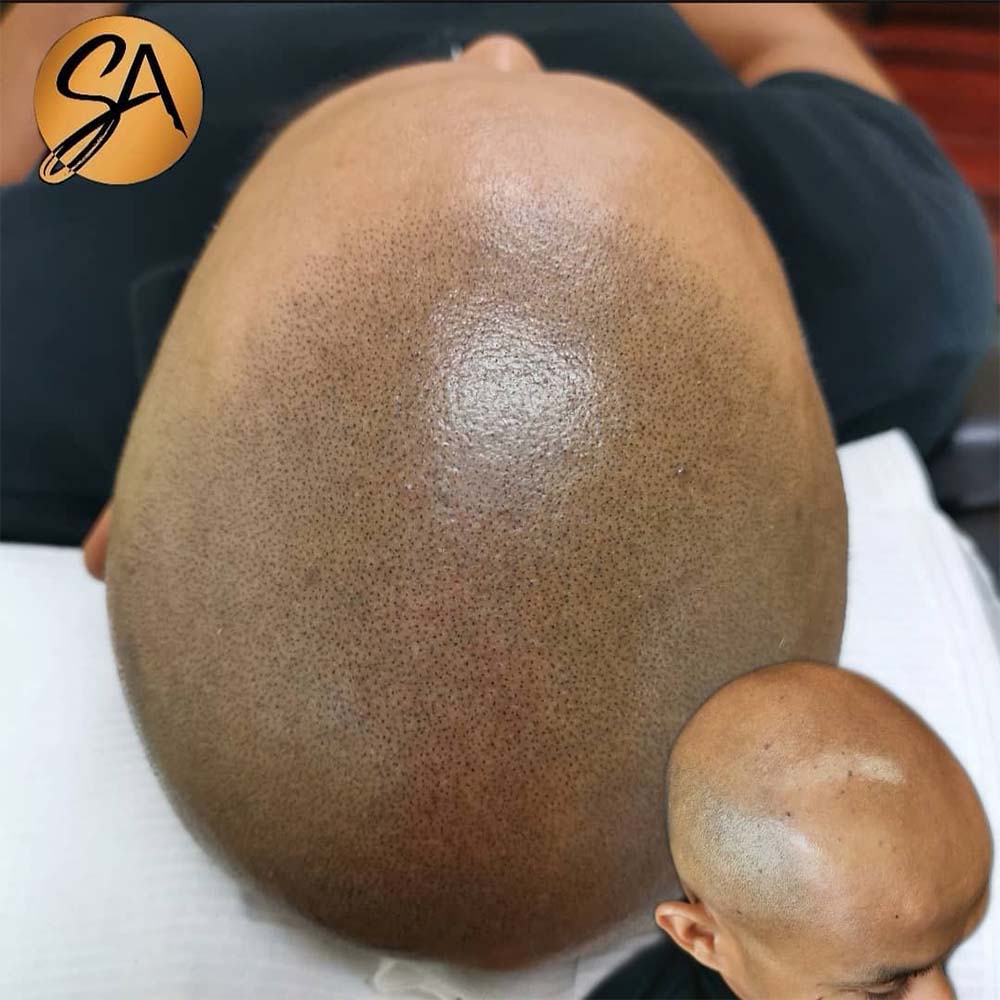
How Long Does SMP Healing Take?
Since SMP sessions are done so close apart, you will virtually go from one healing cycle straight into another. This means healing is completely over 4 weeks after your last session.
This is how long it takes for the pigments to show their true color, and for the tissue to heal completely. After that, you don’t need to pay any special attention to your scalp, but try to minimize sunlight exposure and wear SPF when outdoors – sun radiation speeds up pigment fading.
SCALP MICROPIGMENTATION TOUCH UPS
When Should You Get an SMP Touch Up?
The 2nd and 3rd sessions are mandatory in most cases, and most artists include them in the original price of the treatment. But after you achieve the desired saturation and color, you won’t have to worry about touch ups for at least a few years.
You can get color refresher touch ups when you feel like your results have faded significantly. Many clients only come back after 4 years, or even longer. It all depends on the pace at which your pigments fade.
Generally, it’s best to book a touch up as soon as you notice the fade is significant. The further the pigments fade, the more work will be needed and the price of the session will increase.
SCALP MICROPIGMENTATION CORRECTION
Can Scalp Micropigmentation Go Wrong?
The possible side-effects of the treatment come down to infections, allergic reactions, and permanent scarring. All of these can be prevented if you go to a certified, licensed and experienced artist who knows what they’re doing, does a patch test and gives clear aftercare instructions you’ll follow.
Botched SMP is highly unlikely to happen, but you might end up not liking the outline of the hairline or the color. If that’s the case, you can have the shape fixed at an additional touch up (with the same artist or a different one), and the color can be corrected.
Contact an artist and let them assess how the situation can be fixed.
Can Scalp Micropigmentation Be Removed?
If you decide you want to get rid of your scalp pigmentation at some point, you can get laser removal. SMP is usually not removed with other methods like saline or acid removal, because the area is simply too large.
The process implies having the laser break down the pigment particles, which are then extracted by the system. Removal is done over several sessions (in some cases, as many as 10), and the process can drag out for months and the bills can pile up. Also, it’s known to be quite uncomfortable, even painful.
So perhaps it’s better to wait out until the pigments fade on their own
SCALP MICROPIGMENTATION COST
How Much Does SMP Cost?
The price of the SMP treatment can vary significantly based on many factors, the primary one being the size of the area treated. The general range is between $2000 and $4500, with scar camouflage or receding hairline priced towards the cheaper end of the scale, and full head treatment being the most expensive.
To find out how much it would cost to treat your particular case, contact an artist and let them assess the amount of work that needs to be done.
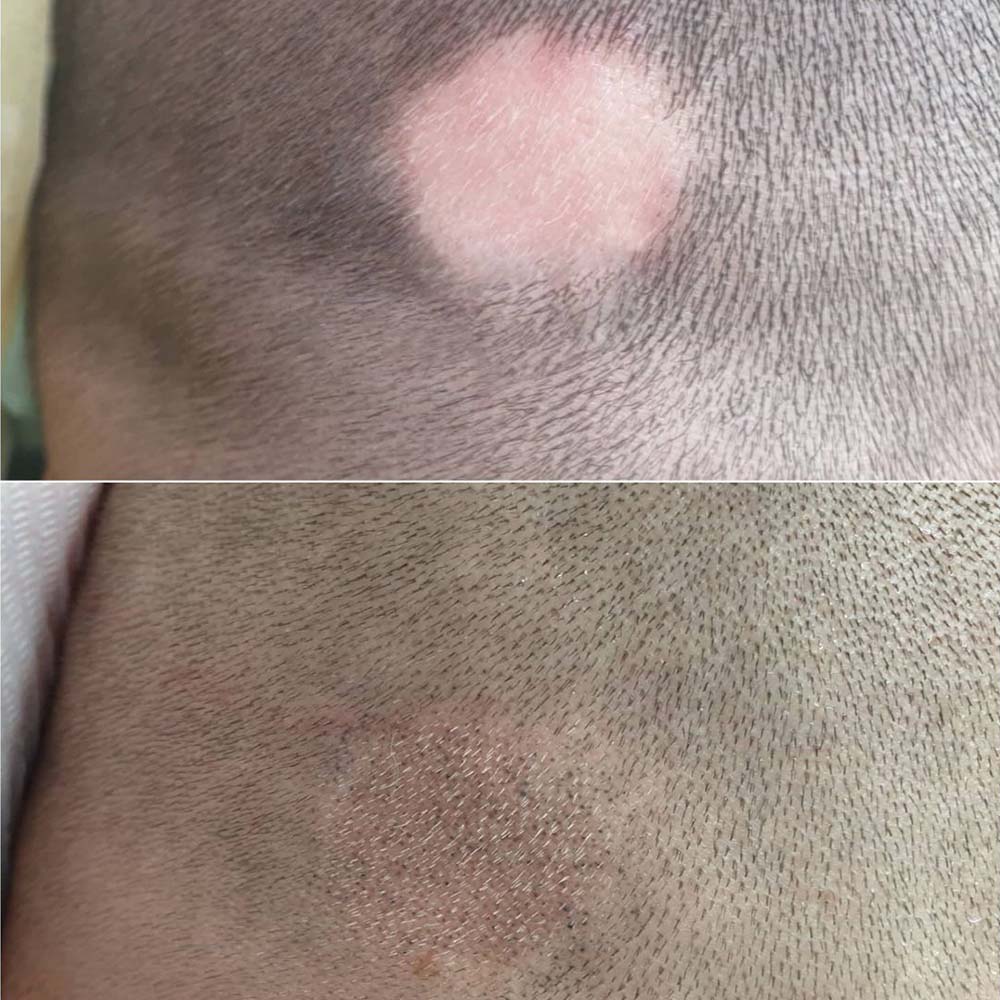
SCALP MICROPIGMENTATION – MAIN TAKEAWAYS
Scalp micropigmentation is arguably the most successful method of camouflaging hair loss and camouflaging scars or bald patches on the scalp since it gives immediate results and there’s no way for it not to work. It’s a type of cosmetic tattooing – it’s done by inserting dots of pigment into the skin of the scalp. It gives a buzz-cut look or an illusion of more volume, and the results can last as long as 10 years.
weekly insight into PMU insdustry
Subscribe to our FREE newsletter. 100% good stuff.

support us so we can keep providing you with free education , information and inspiration.
